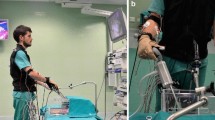Abstract
Background
In minimally invasive surgery, hand suturing is categorized as a challenge in technique as well as in its duration. This calls for an easily manageable tool, permitting an all-purpose, cost-efficient, and secure viscerosynthesis. Such a tool for this field already exists: the Autosuture EndoStitch®. In a series of studies the potential for the EndoStitch to accelerate suturing has been proven. However, its ergonomics still limits its applicability. The goal of this study was twofold: propose an optimized and partially automated EndoStitch and compare the conventional EndoStitch to the optimized and partially automated EndoStitch with respect to the speed and precision of suturing.
Methods
Based on the EndoStitch, a partially automated suturing tool has been developed. With the aid of a DC motor, triggered by a button, one can suture by one-fingered handling. Using the partially automated suturing manipulator, 20 surgeons with different levels of laparoscopic experience successfully completed a continuous suture with 10 stitches using the conventional and the partially automated suture manipulator. Before that, each participant was given 1 min of instruction and 1 min for training. Absolute suturing time and stitch accuracy were measured. The quality of the automated EndoStitch with respect to manipulation was tested with the aid of a standardized questionnaire.
Results
To compare the two instruments, t tests were used for suturing accuracy and time. Of the 20 surgeons with laparoscopic experience (fewer than 5 laparoscopic interventions, n = 9; fewer than 20 laparoscopic interventions, n = 7; more than 20 laparoscopic interventions, n = 4), there was no significant difference between the two tested systems with respect to stitching accuracy. However, the suturing time was significantly shorter with the Autostitch (P = 0.01). The difference in accuracy and speed was not statistically significant considering the laparoscopic experience of the surgeons. The weight and size of the Autostitch have been criticized as well as its cable. However, the comfortable handhold, automatic needle change, and ergonomic manipulation have been rated positive.
Conclusion
Partially automated suturing in minimally invasive surgery offers advantages with respect to the speed of operation and ergonomics. Ongoing work in this field has to concentrate on minimization, implementation in robotic systems, and development of new operation methods (NOTES).




Similar content being viewed by others
References
Feussner H (2003) The operating room of the future: a view from Europe. Semin Laparosc Surg 10(3):149–156
Szabo Z, Cuschieri A (1995) Tissue approximation in endoscopic surgery. ISIS Medical Media, Oxford
Bermas H, Fenoglio M, Haun W, Moore JT (2004) Laparoscopic suturing and knot tying: a comparison of standard techniques to a mechanical assist device-case report. JSLS 8:187–189
Andrews SM, Lewis JL (1994) Laparoscopic knot substitutes. An assessment of techniques of securing sutures through the laparoscope. Endosc Surg Allied Technol 2(1):62–65
Melzer A, Schurr MO, Lirici MM, Klemm B, Stöckel D, Buess G (1994) Future trends in endoscopic suturing. Endosc Surg Allied Technol 2(1):78–82
Melzer A, Buess G, Trapp R, Brehl KP (1993) Surgical Stitching Instrument, International Patent WO/1993/001750, Publication Date 4 February 1993
Takiguchi S, Sekimoto M, Fujiwara Y, Miyata H, Yasuda T, Doki Y, Yano M, Monden M (2005) A simple technique for performing laparoscopic purse-string suturing during circular stapling anastomosis. Surg Today 35(10):869–899
Nguyen N, Mayer KL, Bold RJ, Larson M, Foster S, Ho HS, Wolfe BM (2000) Laparoscopic suturing evaluation among surgical residents. J Surg Res 93:133–136
Pattaras JG, Smith GS, Landman J, Moore RG (2001) Comparison and analysis of laparoscopic intracorporeal suturing devices: preliminary results. J Endourol 15(2):187–192
Ipek T, Altinli E, Yuceyar S, Erturk S, Eyuboglu E, Akcal T (2002) Laparoscopic repair of a Morgagni-Larrey hernia: report of three cases. Surg Today 32:902–905
Nolan P et al (1996) Method of Employing Surgical Suturing Apparatus to Tie Knots. U.S. Patent 5480406, January 2, 1996
Fukunaga M, Kidokoro A, Iba T, Sugiyama K, Fukunaga T, Nagakari K, Suda M, Yosikawa S (2004) Laparoscopic surgery for left paraduodenal hernia. J Laparosc Adv Surg Tech 14(2):111–115
Cao CG, MacKenzie CL, Payandeh S (1996) Task and Motion Analyses in Endoscopic Surgery. ASME IMECE Conference Proceedings: 5th Annual Symposium on Haptic Interfaces for Virtual Environment and Teleoperator Systems, Atlanta, Georgia, November 1996, pp 583–590
Risucci D, Geiss A, Gellman L, Pinard B, Rosser J (2001) Surgeon-specific factors in the acquisition of laparoscopic surgical skills. Am J Surg 181(4):289–293
Shennib H, Korkola SJ, Bousette N, Giaid A (2000) An automated interrupted suturing device for coronary artery bypass grafting: automated coronary anastomosis. Ann Thorac Surg 70(3):1046–1048
Kim KB, Cho KR, Choi JS, Ki EH (2004) Initial experience of an automated anastomotic distal device in off-pump CABG. Heart Surg Forum 7(5):E360–E363
Jernigan SR, Chanoit G, Veeramani A, Owen SB, Hilliard M, Cormier D, Laffitte B, Buckner G (2010) A laparoscopic knot-tying device for minimally invasive cardiac surgery. Eur J Cardiothorac Surg 37(3):626–630
Kuniholm JF, Buckner GD, Nifong W, Orrico M (2005) Automated knot tying for fixation in minimally invasive, robot-assisted cardiac surgery. J Biomech Eng 127(6):1001–1008
Brehmer B, Moll C, Makris A, Kirschner-Herrmanns R, Knüchel R, Jakse G (2008) Endosew: New device for laparoscopic running sutures. J Endourol 22(2):307–311
Kang H, Wen JT (2001) Robotic assistants aid surgeons during minimally invasive procedures. IEEE Eng Med Biol 20(1):94–104
Acknowledgments
This work was funded by the Kuratorium Klinischer Forschung (KKF 1-03-06) of the Technische Universität München.
Disclosures
Tobias Göpel, Felix Härtl, Armin Schneider, Martin Buss, and Hubertus Feussner have no conflicts of interest or financial ties to disclose.
Author information
Authors and Affiliations
Corresponding author
Rights and permissions
About this article
Cite this article
Göpel, T., Härtl, F., Schneider, A. et al. Automation of a suturing device for minimally invasive surgery. Surg Endosc 25, 2100–2104 (2011). https://doi.org/10.1007/s00464-010-1532-x
Received:
Accepted:
Published:
Issue Date:
DOI: https://doi.org/10.1007/s00464-010-1532-x




